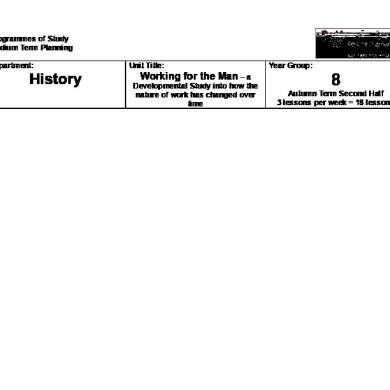The Punishment Of Vagrants
This document was uploaded by user and they confirmed that they have the permission to share it. If you are author or own the copyright of this book, please report to us by using this DMCA report form. Report DMCA
Overview
Download & View The Punishment Of Vagrants as PDF for free.
More details
- Words: 213
- Pages: 3
The punishment of vagrants Between 1531 and 1598, various laws were passed which set down the punishments for vagrancy - these included whipping, being branded with the letter ‘V’ on their forehead, or being sent into slavery for two years. Those convicted of a second offence of vagrancy could be executed, or sold into slavery for life. Later, some of these punishments were repealed as being too harsh. Eventually, the authorities realised there were genuine cases of poverty. They tried to distinguish between ‘impotent poor’ and 'dishonest poor'.
In 1572, J. P. s were given powers to collect a weekly poor-rate (tax) from each parish to help provide for poor people who were genuinely ill, disabled or too old to work. In 1598, a system of ‘overseers of the poor’ in each parish was introduced. However, special institutions - houses of correction - were set up to deal with the ‘sturdy’ poor. In 1601, the Great Poor Law Act brought together all previous measures to help the poor, and ordered local councils to collect a poor rate to provide workhouses and hospitals. This system lasted until 1834 and a new Poor Law Act.
From about 1650, the rate of population growth began to slow down - this helped reduce the volume of poverty.
In 1572, J. P. s were given powers to collect a weekly poor-rate (tax) from each parish to help provide for poor people who were genuinely ill, disabled or too old to work. In 1598, a system of ‘overseers of the poor’ in each parish was introduced. However, special institutions - houses of correction - were set up to deal with the ‘sturdy’ poor. In 1601, the Great Poor Law Act brought together all previous measures to help the poor, and ordered local councils to collect a poor rate to provide workhouses and hospitals. This system lasted until 1834 and a new Poor Law Act.
From about 1650, the rate of population growth began to slow down - this helped reduce the volume of poverty.
Related Documents

The Punishment Of Vagrants
August 2019 22
Doctrine Of Capital Punishment
December 2019 17
Capital Punishment
June 2020 8
The Grave (punishment And Blessings)
July 2020 29
Capital Punishment
May 2020 18
Punishment Letter
May 2020 2More Documents from "Sly"

Harris Longterm Plan Y12 Boombust-germany
October 2019 31
Y8 Autumn Medium Term Plan - Work
October 2019 34
Y7 Longterm 2007-8 Rule Religion Remedies
October 2019 28
Slavery Source Book
October 2019 41
Hcc Newsletter
November 2019 31